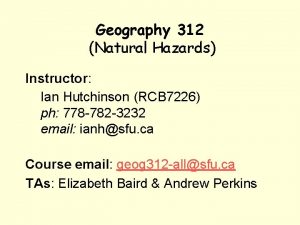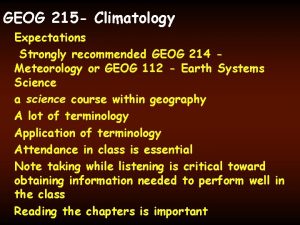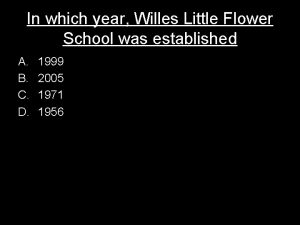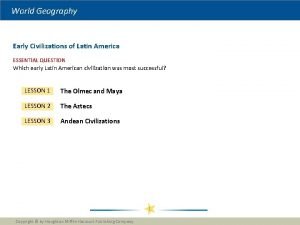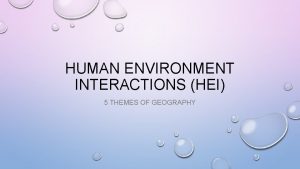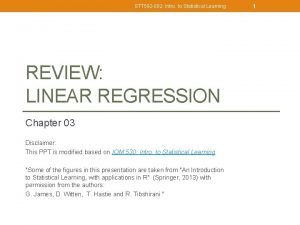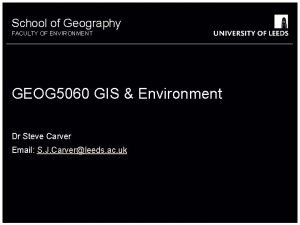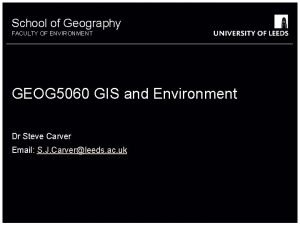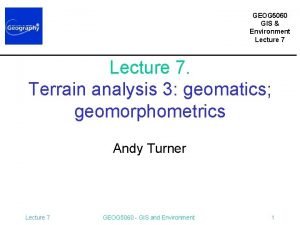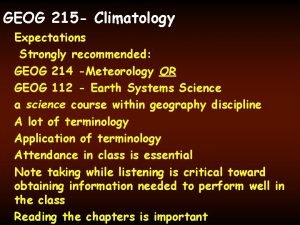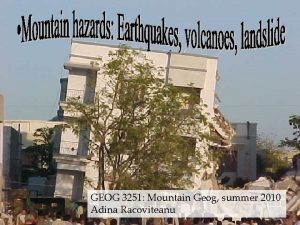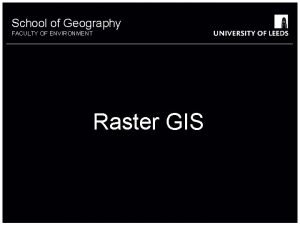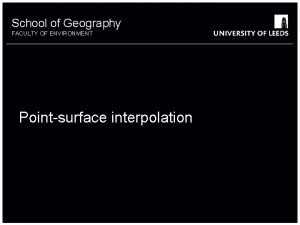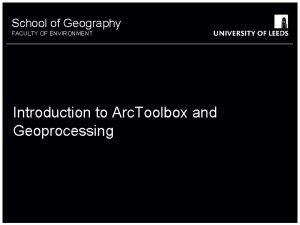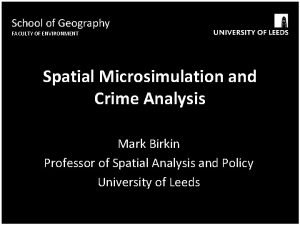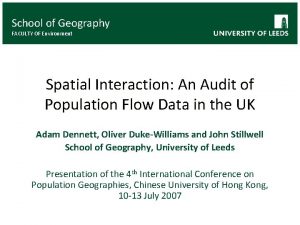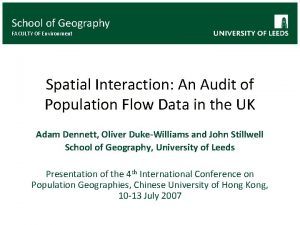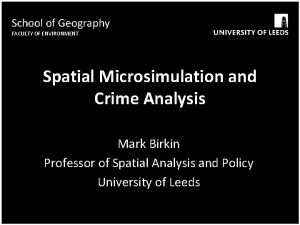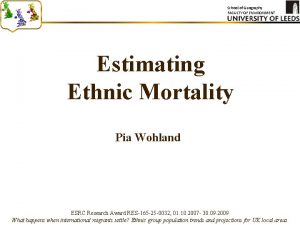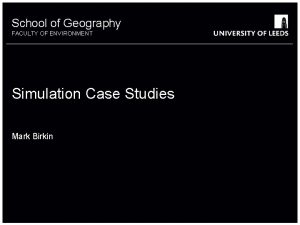School of Geography FACULTY OF ENVIRONMENT GEOG 5060

































- Slides: 33

School of Geography FACULTY OF ENVIRONMENT GEOG 5060 GIS & Environment Dr Steve Carver Email: S. J. Carver@leeds. ac. uk

School of Geography FACULTY OF ENVIRONMENT Lecture 1: Space-time variability Outline: • module introduction • what makes environmental applications of GIS different? • environmental science and management • the role of GIS?

School of Geography FACULTY OF ENVIRONMENT Module outline: • Convenor: Dr Steve Carver • Others: Andy Turner • 11 x 1 hour lectures • 11 x 1 hour workshops • 11 x 2 hour GIS practical classes Assessment: • 2 x 750 word practical assignments (25% each) • 1 x 1500 word practical project (50%)

School of Geography FACULTY OF ENVIRONMENT 1. Space-time variability (SC) 2. Working with environmental data (SC) 3. Error and uncertainty (SC) 4. Grid-based modelling (SC) 5. Terrain modelling 1: the basics (SC) 6. Terrain modelling 2: applications (SC) 7. Terrain modelling 3: geometrics (AT) 8. Hydrological modelling 1: catchment models (SC) 9. Hydrological modelling 2: runoff models (SC) 10. Land suitability modelling (SC) 11. Spatial decision support systems (SC)

School of Geography FACULTY OF ENVIRONMENT Aims: To provide an introduction to environmental applications of GIS; and To develop knowledge and understanding of concepts, issues and problems specific to environmental applications of GIS

School of Geography FACULTY OF ENVIRONMENT Objectives: Identify principles and functional issues pertaining to environmental applications of GIS; Examine and review specific application areas where GIS is a useful tool; Investigate techniques provided by GIS which have particular relevance to environmental applications and problem solving; and Identify and address problem areas such as data sources, modelling, error and uncertainty

School of Geography FACULTY OF ENVIRONMENT On completion of this module students should be able to: • demonstrate a clear knowledge and understanding of the key concepts concerning the application of GIS to environmental problems; • show an appreciation of the space-time variability within environmental data and what this means for GIS applications in the field; • demonstrate a high level of skill in the application of GIS software (principally Arc. GIS) to the solving of environmental problems; and • develop their own environmental applications of GIS.

School of Geography FACULTY OF ENVIRONMENT Lecture 1 Principles of GIS for environmental applications: space-time variability

School of Geography FACULTY OF ENVIRONMENT What makes environmental applications of GIS different? The natural environment is… • extremely complex • highly variable (space and time) • complicated further by human action Understanding of natural systems. . . • very basic • multiple approaches to natural science

School of Geography FACULTY OF ENVIRONMENT Real world modelling From this… …to this

School of Geography FACULTY OF ENVIRONMENT Spatio-temporal variation Range of variability over a range of spatial and temporal scales • variation depends on the scale of observation • e. g. vegetation (species, community, ecosystem) • sliding scale to represent both spatial and temporal variability • i. e. space from infinitesimal (zero) to infinite • i. e. time from the instantaneous to ‘for ever’

School of Geography FACULTY OF ENVIRONMENT Variety of spatial and temporal scales: • micro scale - meso scale - macro scale • e. g. Hydrology • Micro: runoff plots, infiltrometer, hillslope • Meso: sub-catchment, headwaters, reach • Macro: whole catchment, region, watershed • now - sec - min - day - year - century - etc. • e. g. Climatology • Seconds: Wind speeds • Minutes: Incoming solar radiation • Day: Anabatic/katabatic winds • Year: Annual temperature variation • Millennium: Glacial/interglacial periodicity

School of Geography FACULTY OF ENVIRONMENT Complexity Complex nature of environmental systems makes possibility of realistic modelling seem remote Frustrated by lack of understanding • e. g. influence of human activity Variations in complexity: • most GIS applications model only 1 or 2 processes with assumptions/simplification

School of Geography FACULTY OF ENVIRONMENT An ecosystems approach? Need to adopt an ecosystems approach if whole world environmental processes (and human effects) are to be modelled effectively Practicality hampered by: • lack of data and inappropriate data models • lack of storage capacity and slow computing speeds • lack of understanding Must recognise and account for this in GIS

School of Geography FACULTY OF ENVIRONMENT Question… How can sampling strategies be matched to spatio-temporal scales?

School of Geography FACULTY OF ENVIRONMENT Sampling theory Sampling spatial processes: • the sampling frequency needs to be small enough to record local variations without undue generalisation of spatial pattern but coarse enough so as to avoid data redundancy Sampling temporal processes: • in order to record variations in temporal processes sampling frequency needs to be about half the wavelength of the process to avoid measurement bias and too much detail Sampling dependent on process(es) operating

School of Geography FACULTY OF ENVIRONMENT DEM Cell size 1 Cell size 2 1 wavelength Rate amplitude Time

School of Geography FACULTY OF ENVIRONMENT Question… How do we choose appropriate sampling frequencies?

School of Geography FACULTY OF ENVIRONMENT Environmental science Aims of environmental science: • to accumulate knowledge pertaining to the environment? • to understand environmental processes and linkages? Objectives of environmental science: • gather data pertaining to environmental phenomena and processes via empirical investigation? • to develop theories encompassing environmental themes i. e. gain understanding/insight through study

School of Geography FACULTY OF ENVIRONMENT Environmental management Aims of environmental management: • to prevent deterioration and degradation? • to promote sustainable use of the environment? • to prevent over use/exploitation of natural resources? • to preserve environmental diversity? Objectives of environmental management: • to control the environment and/or our influences upon the environment via direct or indirect action? i. e. putting environmental science to work!

School of Geography FACULTY OF ENVIRONMENT The role of GIS? In environmental science: • data management tool • investigative and experimental tool • framework for analysis (and particularly modelling) In environmental management: • decision-support tool • applications framework i. e. GIS as a facilitator/enabling technology

School of Geography FACULTY OF ENVIRONMENT Policy focus Acceptable technology • endorsement by government • Chorley Report (1987) in UK • Setting up of NCGIA in USA • acknowledgement of environmental problems • White Paper (1990) • UN ‘Earth Summit’ Rio de Janeiro (1992) • need for “Best available scientific evidence”

School of Geography FACULTY OF ENVIRONMENT Advantages of GIS is good at… • handling spatial data • visualisation of spatial data • integrating spatial data • framework for: • analysis and modelling • decision support

School of Geography FACULTY OF ENVIRONMENT (dis)Advantages of GIS is not so good at… • handling temporal data • visualisation of temporal data • integrating spatial and temporal data • framework for: • analysis and modelling of time dependent data • volumetric analysis • uncertainty

School of Geography FACULTY OF ENVIRONMENT GIS alone is not enough Integrated systems: • limited ‘off-the-shelf’ spatial analysis and modelling • framework for developing better integrated systems • GIS - image processing systems • GIS - modelling systems • GIS - statistical software • facilitated through • specialist programming languages (e. g. AML and Avenue) • universal programming languages (e. g. Java and Visual Basic) • access to source code (e. g. GRASS)

School of Geography FACULTY OF ENVIRONMENT Integrated systems Combined (symbiotic) systems Example: • NERC/ESRC Land Use Programme (NELUP): decision support for land use change in UK • GRASS GIS • models: hydrological (SHE), agricultural economics and ecological • Graphic User Interface (GUI) • Spatial Decision Support System (SDSS)

School of Geography FACULTY OF ENVIRONMENT NELUP

School of Geography FACULTY OF ENVIRONMENT Conclusions The environment is complex and our understanding simple • environmental data is highly variable • implications for GIS applications GIS has important role to play in environmental science and management • handling and analysing spatial data • problems with temporal data

School of Geography FACULTY OF ENVIRONMENT Workshop Space-time variability in environmental data: issues and implications for GIS • What are the key issues and concerns regarding the high level of spacetime variability observed in environmental data? • What approaches do we need to adopt in order to cope with this variability? • What are the implications for GIS analyses and the development of the technology?

School of Geography FACULTY OF ENVIRONMENT Practical Spatial variability in environmental data Task: Investigate the spatial variability in selected environmental datasets and determine the effects of a) sampling strategy, and b) resolution on the data. Data: The following datasets are provided for the Upper Wharfe area… • 2 m (Li. DAR), 10 m (OS Landform Profile), 25 m (Landmap), 50 m (OS Landform Panorama) and 75 m (SRTM) resolution digital elevation models • OS Landform Profile contour data (10 m interval)

School of Geography FACULTY OF ENVIRONMENT Steps: 1. Display all elevation datasets and look for visible differences - do these result from differences in sampling strategy or resolution or both? 2. Aggregate all datasets to 100 m and compare both outputs - what are the differences due to? (use resample in GRID or aggregate in Arc. Map toolbox to specify the new cell size) 3. Calculate the slope (gradient) from all the DEM data – is there any ‘striping’ in the slope data and what might this be due to? (use slope in GRID or Arc. Map Spatial Analyst to calculate slope)

School of Geography FACULTY OF ENVIRONMENT Familiarity with scale issues especially resolution and sampling in relation to spatial variation in environmental data Experience/practice in use of display functions in Arc. GIS (GRID and Arc. Map) Familiarity with various terrain model products

School of Geography FACULTY OF ENVIRONMENT Next week… Working with environmental data • general characteristics of environmental data • environmental data sources • toward integrated databases Workshop: sourcing and uses of environmental data Practical: creating an environmental database using GPS
 Unit 1 geog. of ga/ga’s beginnings
Unit 1 geog. of ga/ga’s beginnings May subd geog
May subd geog Geog 312 sfu
Geog 312 sfu Dse geog essay sample
Dse geog essay sample Geog 214
Geog 214 Geog
Geog Financial environment in business environment
Financial environment in business environment Hahnville high school faculty
Hahnville high school faculty Wills little flower school
Wills little flower school Emory anticoagulation clinic
Emory anticoagulation clinic Geography/environment of olmec
Geography/environment of olmec What is hei in geography
What is hei in geography How to write an frq for ap human geography
How to write an frq for ap human geography 5 themes of geography ap human geography
5 themes of geography ap human geography Stateless nation
Stateless nation External environments and accountability of schools
External environments and accountability of schools Product differentiation
Product differentiation Eric’s favourite .......... is science. *
Eric’s favourite .......... is science. * Geography fieldwork in school grounds
Geography fieldwork in school grounds Clil geography primary school
Clil geography primary school Herszon kherson maritime college of merchant marine fleet
Herszon kherson maritime college of merchant marine fleet University of bridgeport computer science
University of bridgeport computer science University of bridgeport computer science faculty
University of bridgeport computer science faculty Alamo colleges faculty salary schedule
Alamo colleges faculty salary schedule Importance of faculty in higher education
Importance of faculty in higher education Hubert kairuki memorial university faculty of medicine
Hubert kairuki memorial university faculty of medicine Http://www-bcf.usc.edu/~gareth/isl/advertising.csv
Http://www-bcf.usc.edu/~gareth/isl/advertising.csv Semmelweis university faculty of medicine
Semmelweis university faculty of medicine Penn state neurosurgery
Penn state neurosurgery Mercy college adjunct positions
Mercy college adjunct positions Faculty of medicine nursing and health sciences
Faculty of medicine nursing and health sciences Lee kong chian faculty of engineering and science
Lee kong chian faculty of engineering and science King abdulaziz university faculty of medicine
King abdulaziz university faculty of medicine Carelli
Carelli


